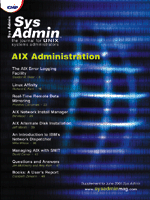 Linux
Affinity Linux
Affinity
Richard Ferri
The success of Linux and open source over the recent months has
made many of the traditionally high-end UNIX vendors take notice.
IBM, Sun Microsystems, and Hewlett-Packard have all announced steps
to embrace Linux on their traditionally high-end, enterprise UNIX
operating systems, AIX, Solaris, and HP-UX, respectively. All three
companies have either provided a method of porting applications
from Linux to their operating system or ported a number of Linux
applications and made them available to the public, or both. What
interest do these time tested, UNIX vendors have in this upstart
Linux? After all, it's clear to those who follow UNIX that
Linux is the least mature operating system of the four. Why would
these lofty distributors care about embracing Linux?
Strategic Approaches to Linux Affinity
If you look at the explosion of the open source community, examine
the curriculum among college and graduate students, and check out
various publishers' book offerings, the signs are clearly there
-- Linux is coming. With its acceptance by the major UNIX vendors,
one might even say that Linux has arrived. Given the number of talented
developers working in Linux and open source, the number of machines
now installed with Linux, the skill set that new programmers coming
out of college have acquired, IBM, Sun, and HP have all realized
that Linux skills and numbers of devotees are growing at a faster
rate than for their respective operating systems. So, why not accommodate
these new Linux devotees with the best of both worlds? They can
have the look and feel of Linux, and their favorite Linux applications,
on more mature operating systems like AIX, Solaris, and HP-UX.
The three vendors have taken similar approaches to Linux affinity.
HP-UX provides libhplx, which is a library that contains
about 200 Linux-compatible APIs, related file headers, and their
sources. This library is a set of APIs not available with HP-UX,
taken from GNU 2.1.3, and is available under the GNU Public License
(GPL). At LinuxWorld Expo in February, HP announced that they will
be shipping the open source Ximian GNOME Desktop as their default
desktop for HP-UX workstations. HP also announced they will be using
GNOME as the open standard to provide a common desktop for both
their HP-UX and HP Linux workstations. Similarly, Sun has announced
that it will be using a GNOME-based desktop for Solaris. Gnome provides
Solaris with programming libraries, and access to Sun's Star
Office desktop office suite. The intent is that the user will not
be able to tell if he's running RedHat Linux or Solaris under
the hood (ZDNet). As the result of collaboration between Sun and
the open source lxrun project, the lxrun utility allows
Linux binaries to run without modification on Solaris Operating
Environment on Intel platforms. lxrun is a software layer
that sits between Solaris and the Linux Intel binary executable
and remaps system calls "on the fly" allowing them to
run unmodified on Solaris (http://www.sun.com). lxrun
appears to provide a robust environment, supporting such diverse
applications as WordPerfect, GNOME, GIMP, and Quake III.
IBM has made a big commitment to Linux affinity with its AIX operating
system. After all, the "L" in the AIX 5L release due out
later this year is for "Linux". Many applications developed
on and for Linux can run on AIX 5L with a simple recompilation of
the source code, allowing customers to combine Linux applications
with the advanced scalability and availability features of AIX.
Linux affinity on AIX includes Linux application source compatibility,
compliance with emerging Linux standards, and a GNU/Linux build-time
environment with tools and utilities that combine to facilitate
the development and deployment of Linux applications on AIX 5L (http://www.ibm.com/servers/aix/overview/linux.html).
Having given a flavor of what is going on in the industry with regard
to Linux affinity, I will explore how IBM is going about providing
Linux affinity in AIX.
AIX/Linux Affinity
IBM plans to provide Linux affinity in two phases. The first phase
is the release of the AIX Toolbox for Linux Applications, available
at http://www.ibm.com/aix. The AIX Toolbox for Linux Applications
provides GNU and other commonly used tools for recompiling Linux
applications on AIX. The Toolbox provides an API approach for Linux
application affinity. This approach does require a recompile of
the Linux application for AIX using the traditional AIX APIs and
the Toolbox APIs. It does not provide binary compatibility --
no attempt is made to run Linux applications directly on AIX. Given
that the Linux applications are completely recompiled with the AIX
APIs and Toolbox, these applications have access to the reliability,
scalability, and availability traditionally associated with AIX
(see Hebert whitepaper in references section).
The second phase of the Linux affinity plan is an integration
of Linux APIs and header files into AIX 5L Version 5.1. Since AIX
itself was developed to UNIX industry standards, there is inherently
a high degree of compatibility between AIX and Linux. Many Linux
applications can be recompiled and run on AIX 4.3.3 and AIX 5L Version
5.0 today, using the AIX Toolbox. AIX 5L Version 5.1 plans to add
greater compatibility by adding additional API support for functions
that are not presently similar between Linux and AIX (Hebert).
API versus ABI issues
The two major methods of providing affinity for applications running
on two different opearating systems are the API (Application Programming
Interface) and the ABI (Application Binary Interface) methods. In
the API approach, programs are ported to a target operating system
(AIX in this case) from a source operating system (Linux). These
applications should port virtually unchanged -- this is because
the headers and library calls that these applications rely on have
been previously ported to the target operating system. These ported
library routines will result in different operating system service
calls on the target system than they did on the source system. However,
the underlying system service calls are completely hidden from the
application developer. To the application, the library invocation
remains exactly the same. In the ABI approach, binaries are copied
directly from the source system to the target system. These binaries
can then be executed on the target system in an "emulation
mode". There are some advantages and disadvatages of using
the API versus the ABI affinity approaches.
Recompilation
Clearly, the main disadvantage of the API approach is that each
application must be recompiled when brought over from Linux to AIX.
However, since the port has to be done only once, and the set of
APIs provided in AIX is rather complete, this may not be all that
great a disadvantage. A clear advantage of taking the API approach
is that once an application is recompiled for AIX, it becomes an
AIX application and inherits all the stability that AIX provides.
Performance
The issue of performance using the ABI approach is a touchy one.
One would think that the API approach would outperform the ABI approach.
This is because a program ported using the API approach is recompiled
to use the native operating system calls, instead of running in
emulation mode. However, open source projects that provide commands
like lxrun claim that the performance hit is negligible,
in fact, it may not even be measurable. They prefer not to call
lxrun an emulator at all, stating that it's really just
remapping a few system calls, and the rest of the time it remains
undetectable. Systems calls, after all, are used for things like
reading and writing files, displaying information to the screen,
and accessing the network. System calls are not used in computation.
Since the overhead that most I/O requires is far greater than the
amount of time it takes to remap the system calls, the performance
degradation in using the ABI approach instead of the API approach
may be slight or none at all. Admittedly, there will be some noticeable
slow down when running graphics-intensive applications, such as
X Windows.
Application Availability
Using the API approach, IBM has ported most of the major Linux
tools to AIX, including some GNU Tools, such as Gcc Compiler, Gdb
Debugger, Emacs, Automake, Autoconf, Libtool, and hundreds of other
tools, including:
- Application Development -- gcc, g++, gdb,
rpm, cvs, automake, autoconf, libtool,
bison, flex, gettext
- Desktop Environments -- Gnome and KDE
- GNU Base Utilities -- gawk, m4, indent,
sed, tar, diffutils, fileutils, findutils,
textutils, grep, sh-utils
- Programming Languages -- Guile, Python, Tcl/Tk, Rep-gtk
- System Utilities -- emacs, vim, bzip2,
gzip, git, elm, ncftp, rsync,
wget, lsof, less, samba, zip,
unzip, zoo
- Graphics Applications -- ImageMagick, transfig,
xfig, xpdf, ghostscript, gv, mpage
- Libraries -- ncurses, readline, libtiff,
libpng, libjpeg, slang, fnlib, db,
gtk+, qt
- System Shells -- bash2, tcsh, zsh
- Window Managers -- Enlightenment, Sawfish
Architectures
One of the reasons why the ABI method works is that it requires
the underlying architecture of the source and target machines to
be the same. So, when an application binary is copied from Linux
to Solaris, and executed with lxrun, it requires the same
IA-32 architecture to be present on both source and target machines.
lxrun merely executes all the instructions in native mode
until it gets to a system call and remaps the system calls for the
target operating system. This approach does not apply when porting
across architectures, however. There is no easy way to port an IA-32
Linux application to say, a Sparc Station running Solaris unless
something fairly exotic like a machine-level emulator is employed.
Using the API approach, porting across architectures is fairly straightforward,
providing all the standard interfaces are maintained. This means
that a Linux application developed for an IA-32 platform and compiled
using the GNU tools should port to a RS/6000, PowerPC, or IA-64
machine running AIX.
Summary
By porting many standard Linux library routines and headers to
AIX, IBM has attempted to make AIX an operating system friendly
to Linux developers. They have made it friendly to Linux end users
by porting many favorite desktop environments and applications to
AIX. While IBM's API approach to AIX/Linux affinity does require
more work on the part of the porter than an ABI approach, a recompile
is a relatively small price to pay to gain the stability and reliability
inherent in AIX. With AIX 4.3.3, and AIX 5L 5.0, IBM has demonstrated
its commitment to Linux applications and users on AIX; with AIX
5L 5.1, IBM will further demonstrate that long-term commitment.
Acknowledgments and Bibliography
Much of the background information used in this article was taken
from corporate and news Web sites. The sites used as background
material are:
http://www.hp.com
http://www.ibm.com/aix
http://www.devresource.hp.com/LPK/libhplx.html
http://www.linux.hp.com
http://www.linux.hp.com/news_events/ximian.html
http://www.sun.com/linux
http://www.zdnet.com
http://www.ugcs.caltech.edu/~steven/lxrun/lxrun-FAQ.html
http://www.ibm.com/servers/aix/overview/linux.html
http://www.ibm.com/servers/aix/news/aix_affinity.html
I want to acknowledge Dr. David W. Mehaffy of IBM, Austin, Texas,
for his assistance in correcting this text. Much of the information
on AIX/Linux affinity was taken from a technical whitepaper by Ray
Hebert of IBM, Austin, Texas. The paper is available at:
http://www.ibm.com/servers/aix/products/aixos/linux/affinity_linux.pdf
Richard Ferri is a Senior Programmer in the IBM Linux Technology
Center in Poughkeepsie, NY. He works on open source projects like
LUI and OSCAR, an open source clustering tool for high-performance
computing. His previous projects have included network installation
and diagnostics for the RS/6000 SP, and systems management code for
AIX/ESA. He received a BA in English from Georgetown University many
years ago, and now lives in cramped quarters with his wife Pat, three
teenaged sons, and three dogs of various sizes and suspect lineage.
|

